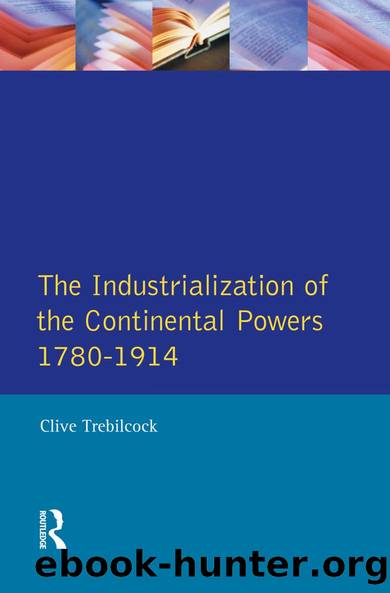Industrialisation of the Continental Powers 1780-1914, The by Clive Trebilcock

Author:Clive Trebilcock [Trebilcock, Clive]
Language: eng
Format: epub
Tags: History, Europe, General
ISBN: 9781317872153
Google: sVkSBAAAQBAJ
Publisher: Routledge
Published: 2014-07-22T16:06:16+00:00
Note: 1 verst = 1.013 km.
Source: Miller (1926), p. 208
The bargain, moreover, was not entirely an economic one. Recent research has greatly strengthened long-running suspicions that much Russian railway construction derived from military inspiration.70 Throughout the 1890s the Finance Ministry experienced pressure both from the French government â too frequently its paymaster â and from the Imperial General Staff to embody its borrowed funds in strategic lines. However much the financial bureaucracy might protest that such projects drained the reserves and diverted foreign credit from more productive uses, the autocracy commonly found the appeals of the militarists more compelling. Consequently, lines like that from Orenburg to Tashkent, aimed by the French against British interests in India, or that from Bologoe to Siedlce, intended to accelerate mobilization against Germany and admitted to be âwithout economic value for the momentâ,71 were constructed against the best interests of an industrializing nation. As Witte conceded, âI tried to develop the railway network as best I could, but military considerations, on whose side his Majesty naturally was for the most part, significantly hindered the building of the railways.â72 At this juncture, the development programmes of the Finance Ministry clearly collided with the political imperatives of the tsarist regime; more particularly, the designs of Witte collided with those of Kuropatkin, the intentions of the reformist technocrat with those of the conservative general.
Given the thin spread and strained viability of the railway routes, their frequent orientation towards frontiers and garrisons rather than factories and mines, the economy of 1914 can scarcely be described as one fully mobilized by railway development. If further proof is needed, the spectacular wartime disruption of the Russian rail network between 1914 and 1917 surely provides it. With consequences so disorderly and pathways so faint, it is therefore a considerable oversimplification to view Witteâs railway programme as a device for proto-planning or as a highway for profitable private enterprise.
Download
This site does not store any files on its server. We only index and link to content provided by other sites. Please contact the content providers to delete copyright contents if any and email us, we'll remove relevant links or contents immediately.
| Natural Resource Extraction | Oil & Energy |
Life 3.0: Being Human in the Age of Artificial Intelligence by Tegmark Max(5476)
The Sports Rules Book by Human Kinetics(4297)
The Age of Surveillance Capitalism by Shoshana Zuboff(4214)
ACT Math For Dummies by Zegarelli Mark(3996)
Unlabel: Selling You Without Selling Out by Marc Ecko(3591)
Blood, Sweat, and Pixels by Jason Schreier(3566)
Hidden Persuasion: 33 psychological influence techniques in advertising by Marc Andrews & Matthijs van Leeuwen & Rick van Baaren(3474)
The Pixar Touch by David A. Price(3366)
Bad Pharma by Ben Goldacre(3357)
Urban Outlaw by Magnus Walker(3342)
Project Animal Farm: An Accidental Journey into the Secret World of Farming and the Truth About Our Food by Sonia Faruqi(3178)
Kitchen confidential by Anthony Bourdain(3014)
Brotopia by Emily Chang(3001)
Slugfest by Reed Tucker(2943)
The Content Trap by Bharat Anand(2863)
The Airbnb Story by Leigh Gallagher(2800)
Coffee for One by KJ Fallon(2569)
Smuggler's Cove: Exotic Cocktails, Rum, and the Cult of Tiki by Martin Cate & Rebecca Cate(2473)
Beer is proof God loves us by Charles W. Bamforth(2375)
